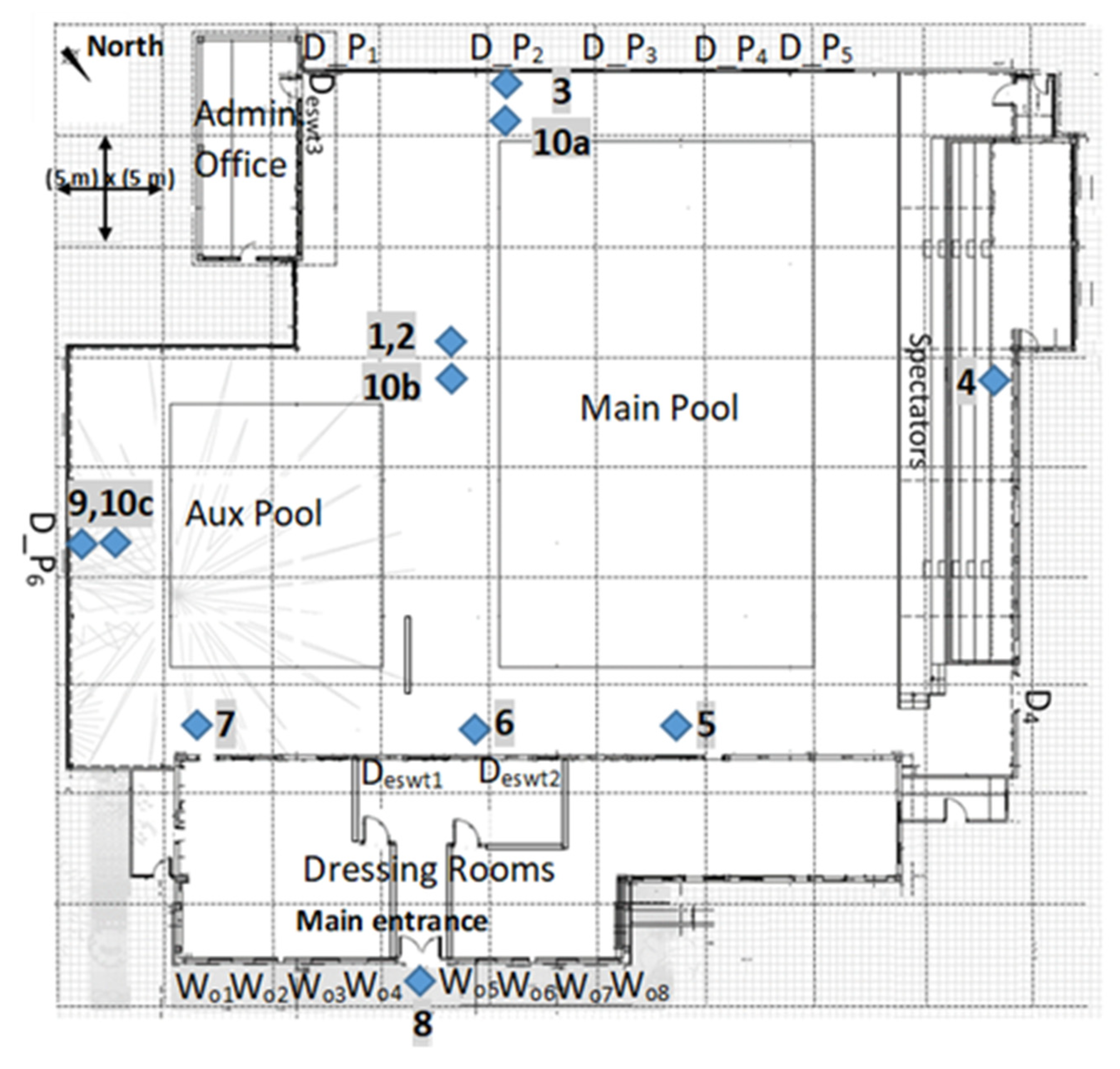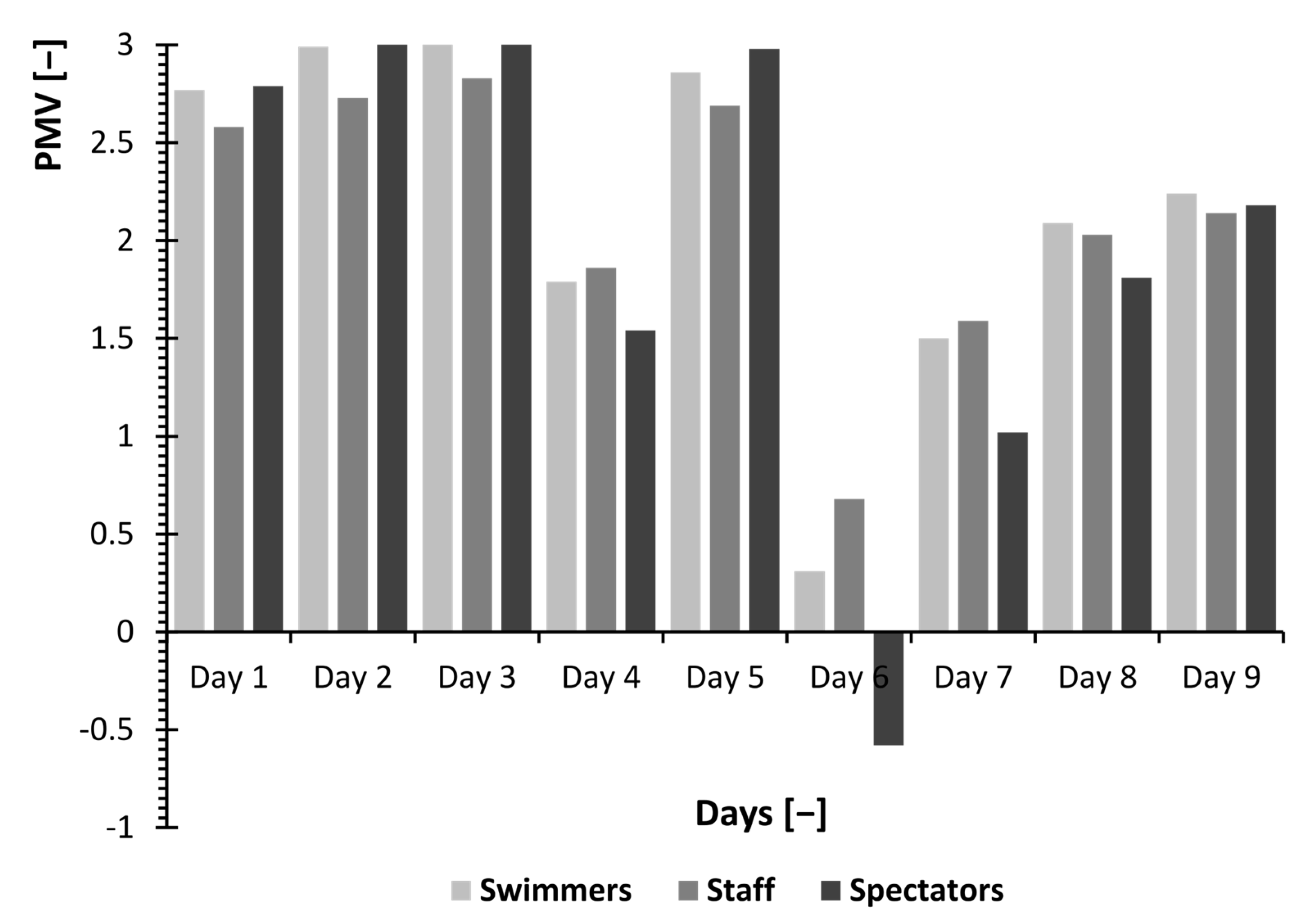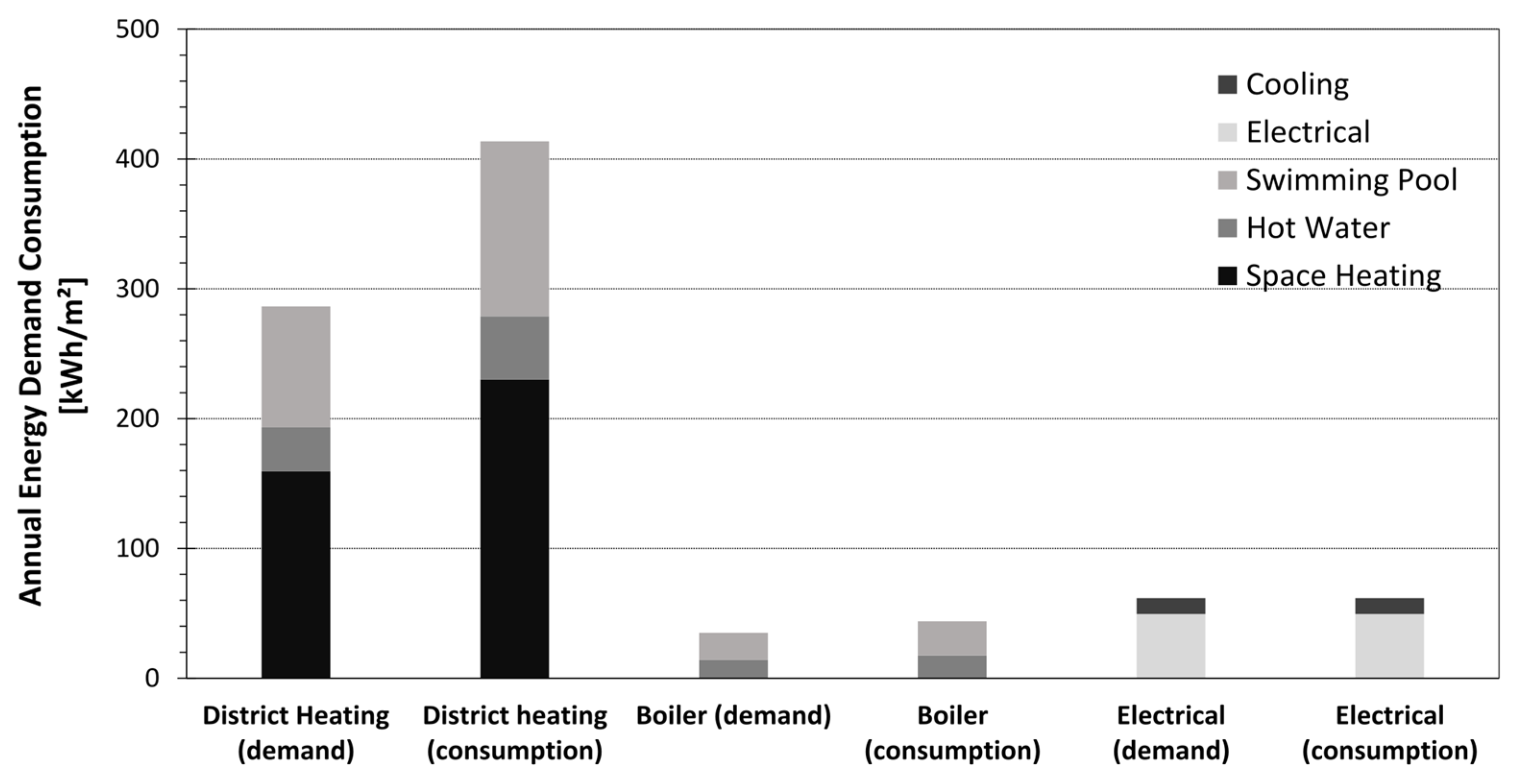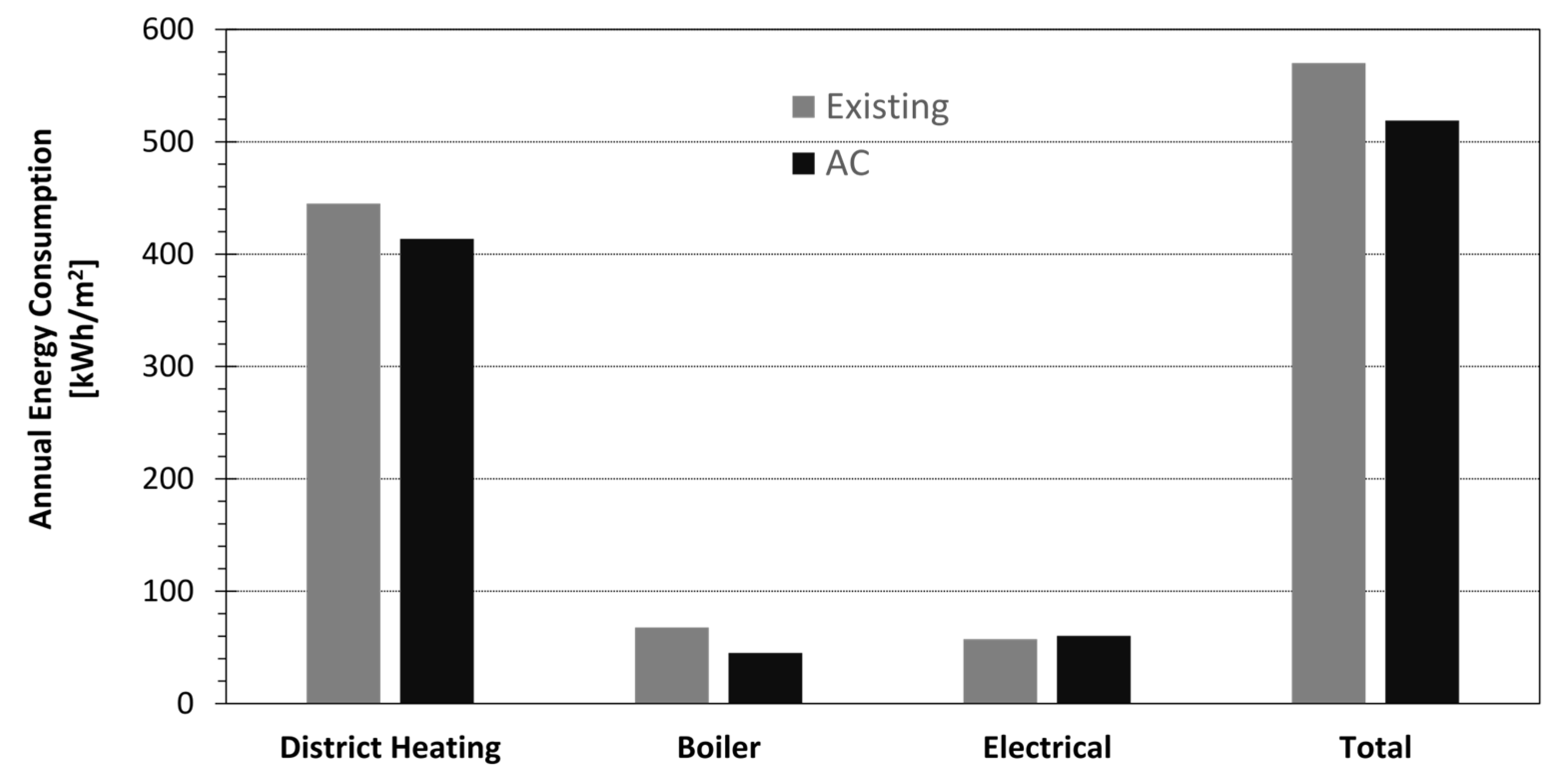Combined Investigation of Indoor Environmental Conditions and Energy Performance of an Aquatic Center
Abstract
1. Introduction
2. Materials and Methods
2.1. Description of the Premises
2.2. Experimental Setup
2.3. Thermal Comfort Methods
2.4. Simulation Analysis Setup and Assumptions
3. Results
3.1. Thermal Comfort Assessment
3.2. Energy Analysis
3.2.1. Present Situation
3.2.2. Air-Conditioning System Scenario
4. Discussion
5. Conclusions
- -
- The operative temperature exceeds the limits of the respective standards for most monitoring days;
- -
- PMV values are far greater than the limit value of +0.5 (or +0.7) for most days and all categories of users (athletes, spectators, staff);
- -
- PMV values of athletes exceed those of spectators and staff in most cases due to their high metabolic rate and the fact that the clothing level of other categories is also low during summertime;
- -
- Indoor air and radiant temperature constitute the main factors affecting thermal comfort;
- -
- Ventilation rate, as demonstrated by the CO2 concentration values, can be increased, contributing to the improvement of thermal comfort, through relative humidity regulation, and IAQ.
Author Contributions
Funding
Institutional Review Board Statement
Informed Consent Statement
Data Availability Statement
Acknowledgments
Conflicts of Interest
Nomenclature
| α | Constant of adaptive model (-) |
| Θrm | Mean outdoor temperature (°C) |
| Ai | Area of different surface (m2) |
| PMV | Predicted mean vote (-) |
| PPD | Predicted percentage of dissatisfied (%) |
| RH | Relative humidity (%) |
| Te(d − i) | Mean daily outdoor temperature for the before day and so on (°C) |
| T | Air temperature (°C) |
| Ti | Surface temperature (°C) |
| Tmpa(out) | Mean outdoor temperature (°C) |
| Tmrt | Mean radiant temperature (°C) |
| U | Thermal parameter values (W/m2 K) |
| AC | Air-conditioning system |
| ASHRAE/ANSI | American Society of Heating, Refrigerating, and Air-Conditioning Engineers |
| CFD | Computational fluid dynamics |
| CEN | European committee for standardization |
| IAQ | Indoor air quality |
| IEQ | Indoor environmental quality |
| ISO | International organization for standardization |
| PCM | Phase change materials |
| TSV | Thermal sensation vote |
| WHO | World Health Organization |
References
- WHO. Physical Activity Strategy for the WHO European Region 2016–2025; World Health Organization: Copenhagen, Denmark, 2016; pp. 1–32.
- Trianti-Stourna, E.; Spyropoulou, K.; Theofylaktos, C.; Droutsa, K.; Balaras, C.A.; Santamouris, M.; Asimakopoulos, D.N.; Lazaropoulou, G.; Papanikolaou, N. Energy Conservation Strategies for Sports Centers: Part B. Swimming Pools. Energy Build. 1998, 27, 123–135. [Google Scholar] [CrossRef]
- Ramos, C.A.; Wolterbeek, H.T.; Almeida, S.M. Exposure to Indoor Air Pollutants during Physical Activity in Fitness Centers. Build. Environ. 2014, 82, 349–360. [Google Scholar] [CrossRef]
- ANSI/ASHRAE Standard 55-2020; Thermal Environmental Conditions for Human Occupancy. ANSI: New York, NY, USA; ASHRAE: Atlanta, GA, USA, 2020.
- EN ISO 7730:2005; Ergonomics of the Thermal Environment—Analytical Determination and Interpretation of Thermal Comfort Using Calculation of the PMV and PPD Indices and Local Thermal Comfort Criteria. European Committee for Standard (CEN): Brussels, Belgium, 2005.
- EN 15251:2012; Indoor Environmental Input Parameters for Design and Assessment of Energy Performance of Buildings-Addressing Indoor Air Quality, Thermal Environment, Lighting and Acoustic. European Committee for Standard (CEN): Brussels, Belgium, 2012.
- EN16798-2:2019; Energy Performance of Buildings—Ventilation for Buildings—Part 2: Interpretation of the Requirements in EN 16798-1—Indoor Environmental Input Parameters for Design and Assessment of Energy Performance of Buildings Addressing Indoor Air Quality, Thermal Environment, Lighting and Acoustics. European Committee for Standard (CEN): Brussels, Belgium, 2019.
- EN ISO 7726:2001; Ergonomics of the Thermal Environment—Instruments for Measuring Physical Quantities. International Organization for Standardization. European Committee for Standard (CEN): Brussels, Belgium, 2001.
- Nicol, J.F.; Humphreys, M.A. Adaptive Thermal Comfort and Sustainable Thermal Standards for Buildings. Energy Build. 2002, 34, 563–572. [Google Scholar] [CrossRef]
- Papadopoulos, G.; Tolis, E.I.; Panaras, G. IEQ Assessment in Free-Running University Classrooms. Sci. Technol. Built Environ. 2022, 28, 823–842. [Google Scholar] [CrossRef]
- Papadopoulos, G.; Panaras, G.; Tolis, E. Thermal Comfort and Indoor Air Quality Assessment in University Classrooms. In IOP Conference Series: Earth and Environmental Science; IOP Publishing: Bristol, UK, 2020; Volume 410, p. 012095. [Google Scholar] [CrossRef]
- Teli, D.; Jentsch, M.F.; James, P.A.B. Naturally Ventilated Classrooms: An Assessment of Existing Comfort Models for Predicting the Thermal Sensation and Preference of Primary School Children. Energy Build. 2012, 53, 166–182. [Google Scholar] [CrossRef]
- d’Ambrosio Alfano, F.R.; Ianniello, E.; Palella, B.I. PMV–PPD and Acceptability in Naturally Ventilated Schools. Build. Environ. 2013, 67, 129–137. [Google Scholar] [CrossRef]
- Trebilcock, M.; Soto-Muñoz, J.; Yañez, M.; Figueroa-San Martin, R. The Right to Comfort: A Field Study on Adaptive Thermal Comfort in Free-Running Primary Schools in Chile. Build. Environ. 2017, 114, 455–469. [Google Scholar] [CrossRef]
- Mustapa, M.S.; Zaki, S.A.; Rijal, H.B.; Hagishima, A.; Ali, M.S.M. Thermal Comfort and Occupant Adaptive Behaviour in Japanese University Buildings with Free Running and Cooling Mode Offices during Summer. Build. Environ. 2016, 105, 332–342. [Google Scholar] [CrossRef]
- Aghniaey, S.; Lawrence, T.M.; Sharpton, T.N.; Douglass, S.P.; Oliver, T.; Sutter, M. Thermal Comfort Evaluation in Campus Classrooms during Room Temperature Adjustment Corresponding to Demand Response. Build. Environ. 2019, 148, 488–497. [Google Scholar] [CrossRef]
- ASHRAE Handbook; HVAC Applications, American Society of Heating, Refrigerating and Air-Conditioning Engineers Inc.: Atlanta, GA, USA, 2003.
- Rajagopalan, P.; Luther, M.B. Thermal and Ventilation Performance of a Naturally Ventilated Sports Hall within an Aquatic Centre. Energy Build. 2013, 58, 111–122. [Google Scholar] [CrossRef]
- Rajagopalan, P.; Jamei, E. Thermal Comfort of Multiple User Groups in Indoor Aquatic Centres. Energy Build. 2015, 105, 129–138. [Google Scholar] [CrossRef]
- Revel, G.M.; Arnesano, M. Perception of the Thermal Environment in Sports Facilities through Subjective Approach. Build. Environ. 2014, 77, 12–19. [Google Scholar] [CrossRef]
- Revel, G.M.; Arnesano, M. Measuring Overall Thermal Comfort to Balance Energy Use in Sports Facilities. Measurement 2014, 55, 382–393. [Google Scholar] [CrossRef]
- EN ISO 10551:2019; Ergonomics of the Physical Environment—Subjective Judgement Scales for Assessing Physical Environments. European Committee for Standard (CEN): Brussels, Belgium, 2019.
- Panaras, G.; Markogiannaki, M.; Tolis, E.I.; Sakellaris, Y.; Bartzis, J.G. Experimental and Theoretical Investigation of Air Exchange Rate of an Indoor Aquatic Center. Sustain. Cities Soc. 2018, 39, 126–134. [Google Scholar] [CrossRef]
- Gouveia, P.; Felgueiras, F.; Mourão, Z.; Fernandes, E.D.O.; Moreira, A.; Gabriel, M.F. Predicting Health Risk from Exposure to Trihalomethanes in an Olympic-Size Indoor Swimming Pool among Elite Swimmers and Coaches. J. Toxicol. Environ. Health Part A 2019, 82, 577–590. [Google Scholar] [CrossRef] [PubMed]
- Salonen, H.; Salthammer, T.; Morawska, L. Human Exposure to Air Contaminants in Sports Environments. Indoor Air 2020, 30, 1109–1129. [Google Scholar] [CrossRef] [PubMed]
- Felgueiras, F.; Mourão, Z.; Morais, C.; Santos, H.; Gabriel, M.F.; de Oliveira Fernandes, E. Comprehensive Assessment of the Indoor Air Quality in a Chlorinated Olympic-Size Swimming Pool. Environ. Int. 2020, 136, 105401. [Google Scholar] [CrossRef]
- Tolis, E.I.; Panaras, G.; Bartzis, J.G. A Comprehensive Air Quality Investigation at an Aquatic Centre: Indoor/Outdoor Comparisons. Environ. Sci. Pollut. Res. 2018, 25, 16710–16719. [Google Scholar] [CrossRef]
- Kampel, W.; Carlucci, S.; Aas, B.; Bruland, A. A Proposal of Energy Performance Indicators for a Reliable Benchmark of Swimming Facilities. Energy Build. 2016, 129, 186–198. [Google Scholar] [CrossRef]
- Duverge, J.J.; Rajagopalan, P.; Fuller, R. Defining Aquatic Centres for Energy and Water Benchmarking Purposes. Sustain. Cities Soc. 2017, 31, 51–61. [Google Scholar] [CrossRef]
- Chow, T.T.; Bai, Y.; Fong, K.F.; Lin, Z. Analysis of a Solar Assisted Heat Pump System for Indoor Swimming Pool Water and Space Heating. Appl. Energy 2012, 100, 309–317. [Google Scholar] [CrossRef]
- Sun, P.; Wu, J.Y.; Wang, R.Z.; Xu, Y.X. Analysis of Indoor Environmental Conditions and Heat Pump Energy Supply Systems in Indoor Swimming Pools. Energy Build. 2011, 43, 1071–1080. [Google Scholar] [CrossRef]
- Lee, W.-S.; Kung, C.-K. Optimization of Heat Pump System in Indoor Swimming Pool Using Particle Swarm Algorithm. Appl. Therm. Eng. 2008, 28, 1647–1653. [Google Scholar] [CrossRef]
- Kuyumcu, M.E.; Tutumlu, H.; Yumrutaş, R. Performance of a Swimming Pool Heating System by Utilizing Waste Energy Rejected from an Ice Rink with an Energy Storage Tank. Energy Convers. Manag. 2016, 121, 349–357. [Google Scholar] [CrossRef]
- Johansson, L.; Westerlund, L. Energy Savings in Indoor Swimming-Pools: Comparison between Different Heat-Recovery Systems. Appl. Energy 2001, 70, 281–303. [Google Scholar] [CrossRef]
- Lazzarin, R.M.; Longo, G.A. Comparison of Heat Recovery Systems in Public Indoor Swimming Pools. Appl. Therm. Eng. 1996, 16, 561–570. [Google Scholar] [CrossRef]
- Tsoka, S. Optimizing Indoor Climate Conditions in a Sports Building Located in Continental Europe. Energy Procedia 2015, 78, 2802–2807. [Google Scholar] [CrossRef]
- Duverge, J.J.; Rajagopalan, P. Assessment of Factors Influencing the Energy and Water Performance of Aquatic Centres. Build. Simul. 2020, 13, 771–786. [Google Scholar] [CrossRef]
- Hunt, J.D.; Zakeri, B.; Leal Filho, W.; Schneider, P.S.; Weber, N.d.A.B.; Vieira, L.W.; Ermel, C.; de Castro, N.J.; Barbosa, P.S.F.; Nascimento, A.; et al. Swimming Pool Thermal Energy Storage, an Alternative for Distributed Cooling Energy Storage. Energy Convers. Manag. 2021, 230, 113796. [Google Scholar] [CrossRef]
- Péez-Carramiñana, C.; Maciá-Mateu, A.; Sirvent-García, G.; Lledó-Llorca, I. Study of Natural Ventilation and Solar Control Strategies to Improve Energy Efficiency and Environmental Quality in Glazed Heated Swimming Pools in a Dry Mediterranean Climate. Sustainability 2022, 14, 8243. [Google Scholar] [CrossRef]
- Energy Plus. Available online: https://energyplus.net/ (accessed on 29 December 2022).
- Tolis, E.I.; Saraga, D.E.; Ammari, G.Z.; Gkanas, E.I.; Gougoulas, T.; Papaioannou, C.C. Chemical characterization of particulate matter (PM) and source apportionme;t study during winter and summer period for the city of Kozani, Greece. Cent. Eur. J. Chem. 2014, 12, 643–651. [Google Scholar]
- Tranoulidis, A.; Sotiropoulou, R.-E.P.; Bithas, K.; Tagaris, E. Decarbonization and Transition to the Post-Lignite Era: Analysis for a Sustainable Transition in the Region of Western Macedonia. Sustainability 2022, 14, 10173. [Google Scholar] [CrossRef]
- Ziouzios, D.; Karlopoulos, E.; Fragkos, P.; Vrontisi, Z. Challenges and Opportunities of Coal Phase-Out in Western Macedonia. Climate 2021, 9, 115. [Google Scholar] [CrossRef]
- Humphreys, M.A.; Nicol, F.J. Understanding the adaptive approach to thermal comfort. ASHRAE Trans. 1998, 104, 991–1004. [Google Scholar]
- Technical Directive 20701-1:2017; Analytical National Requirements for the Parameters Entering the Calculation of Buildings Energy Performance and the Issuing of Energy Certificate. Greek Technical Chamber: Athens, Greece, 2017.
- ASTM E741-11; Standard Test Method for Determining Air Change in a Single Zone by Means of a Tracer Gas Dilution. ASTM International: New York, NY, USA, 2017.
- European Commission. 2030 Framework for Climate and Energy Policies; European Commission: Brussels, Belgium, 2020. Available online: https://climate.ec.europa.eu/eu-action/climate-strategies-targets/2030-climate-energy-framework_en (accessed on 29 December 2022).
- Omidvar, A.; Kim, J. Modification of Sweat Evaporative Heat Loss in the PMV/PPD Model to Improve Thermal Comfort Prediction in Warm Climates. Build. Environ. 2020, 176, 106868. [Google Scholar] [CrossRef]
- Zaki, S.A.; Damiati, S.A.; Rijal, H.B.; Hagishima, A.; Abd Razak, A. Adaptive Thermal Comfort in University Classrooms in Malaysia and Japan. Build. Environ. 2017, 122, 294–306. [Google Scholar] [CrossRef]








| International Standards | Limits of Fanger Model | Limits of Adaptive Model | Measurement Campaign Protocol |
|---|---|---|---|
| ANSI/ASHRAE Standard 55 [4] | −0.5 ≤ PMV ≤ +0.5 | Upper 80% acceptability Limit = 0.31 + 21.3 Lower 80% acceptability Limit = 0.31 + 14.3 | √ |
| ISO 7730 [5] | Category A: −0.2 ≤ PMV ≤ +0.2 Category B: −0.5 ≤ PMV ≤ +0.5 Category C: −0.7 ≤ PMV ≤ +0.7 | - | - |
| EN 15251 [6] | Category I: −0.2 ≤ PMV ≤ +0.2 Category II: −0.5 ≤ PMV ≤ +0.5 Category III: −0.7 ≤ PMV ≤ +0.7 Category IV: PMV < −0.7 or +0.7 < PMV | Category I: Upper limit: 0.33 Θrm + 18.8 + 2 Lower limit: 0.33 Θrm + 18.8 − 2 Category II: Upper limit: 0.33 Θrm + 18.8 + 3 Lower limit: 0.33 Θrm + 18.8 − 3 Category III: Upper limit: 0.33 Θrm + 18.8 + 4 Lower limit: 0.33 Θrm + 18.8 − 4 | - |
| EN 16798-2 [7] | Category I: −0.2 ≤ PMV ≤ +0.2 Category II: −0.5 ≤ PMV ≤ +0.5 Category III: −0.7 ≤ PMV ≤ +0.7 Category IV: −1.0 ≤ PMV ≤ +1.0 | Category I: Upper limit: 0.33 Θrm + 18.8 + 2 Lower limit: 0.33 Θrm + 18.8 − 3 Category II: Upper limit: 0.33 Θrm + 18.8 + 3 Lower limit: 0.33 Θrm + 18.8 − 4 Category III: Upper limit: 0.33 Θrm + 18.8 + 4 Lower limit: 0.33 Θrm + 18.8 − 5 | - |
| ISO 7726 [8] | - | - | √ |
| Position Indication | Measuring Quantity/Instrument Type | Measuring Characteristics |
|---|---|---|
| 1, 3, 5, 7 | T-RH-CCO2/Telaire 7001, Hobo ONSET U12-012 1 | Accuracy: ±0.5 °C (T) 2, ±5% (RH) 2, ±5% or ±50 ppm (CCO2) Range: −20–70 °C (T), 5–95% (RH), 0–2500 ppm 3 (CCO2) |
| 2 | T-RH/Testo 174 H | Accuracy: ±0.5 °C (T), ±3% (RH) Range: −20–70 °C (T), 0–100% (RH) |
| 4, 6, 8 | T-RH/Hobo ONSET H08-003-02 | Accuracy: ±0.5 °C (Τ) 2, ± 5% (RH) 2 Range: −20–70 °C (T), 25–95% (RH) |
| 10a,b,c | Wind Speed (Gill Instruments 3D anemometer) | Accuracy: ±1.5% RMS Range: 0–50 m/s |
| 11 | Meteorological Station (Delta Ohm Hygrotransmitter HD9009TR, Thies CLIMA 4.3515.30.000) | Accuracy: ±0.5 °C (T) 2, ±5% (RH) 2, ±0.5 m/s (u) Range: −40–80 °C (T), 0–100% (RH), 0.5–40 m/s (u) |
| Component | Thermal Parameter Value | |
|---|---|---|
| Existing Situation | Air-Conditioning Scenario | |
| Polyurethane panels | U = 0.9 W/m2 K | U = 0.6 W/m2 K |
| Polyurethane panels (roof) | U = 0.9 W/m2 K | U = 0.55 W/m2 K |
| Concrete walls | U = 2.7 W/m2 K | U = 0.6 W/m2 K |
| Concrete roof | U = 3.05 W/m2 K | U = 0.55 W/m2 K |
| Ground wall | U = 3.1 W/m2 K | U = 2.5 W/m2 K |
| Metallic door | U = 2.6 W/m2 K | U = 2.6 W/m2 K |
| Polycarbonic opening | U = 3.84 W/m2 K | U = 2.6 W/m2 K |
| Aluminum opening | U = 6.1 W/m2 K | U = 2.6 W/m2 K |
| District heating heat exchanger | ηgen = 0.97 (thermal performance) | ηgen = 0.97 (thermal performance) |
| Oil boiler | ηgen = 0.635 (thermal performance) | ηgen = 0.93 (thermal performance) |
| Lighting power | Installed power: 40 kW | 13.3 kW |
| Air-conditioning unit | - | COP = 3 |
| Air exchange rate | 0.7 h−1 (natural ventilation) | 4 h−1 (forced) |
| Swimming pool cover | No | Yes |
| Indoor Space | Outdoor Area | |||||
|---|---|---|---|---|---|---|
| Parameter | Mean | Min | Max | Mean | Min | Max |
| Air temperature (°C) | 30.8 | 23.4 | 37.4 | 30.3 | 18.6 | 36.3 |
| RH (%) | 49.85 | 32.3 | 77.0 | 42.7 | 16.7 | 100 |
| Radiant temperature (°C) | 31.96 | 23.37 | 36.87 | - | - | - |
| CO2 (ppm) | 539.6 | 364.3 | 925.5 | - | - | - |
| Wind speed (m/s) | 0.09 | 0.01 | 0.30 | 0.84 | 0.40 | 1.28 |
Disclaimer/Publisher’s Note: The statements, opinions and data contained in all publications are solely those of the individual author(s) and contributor(s) and not of MDPI and/or the editor(s). MDPI and/or the editor(s) disclaim responsibility for any injury to people or property resulting from any ideas, methods, instructions or products referred to in the content. |
© 2023 by the authors. Licensee MDPI, Basel, Switzerland. This article is an open access article distributed under the terms and conditions of the Creative Commons Attribution (CC BY) license (https://creativecommons.org/licenses/by/4.0/).
Share and Cite
Papadopoulos, G.; Tolis, E.I.; Panaras, G. Combined Investigation of Indoor Environmental Conditions and Energy Performance of an Aquatic Center. Sustainability 2023, 15, 1318. https://doi.org/10.3390/su15021318
Papadopoulos G, Tolis EI, Panaras G. Combined Investigation of Indoor Environmental Conditions and Energy Performance of an Aquatic Center. Sustainability. 2023; 15(2):1318. https://doi.org/10.3390/su15021318
Chicago/Turabian StylePapadopoulos, Giannis, Evangelos I. Tolis, and Giorgos Panaras. 2023. "Combined Investigation of Indoor Environmental Conditions and Energy Performance of an Aquatic Center" Sustainability 15, no. 2: 1318. https://doi.org/10.3390/su15021318
APA StylePapadopoulos, G., Tolis, E. I., & Panaras, G. (2023). Combined Investigation of Indoor Environmental Conditions and Energy Performance of an Aquatic Center. Sustainability, 15(2), 1318. https://doi.org/10.3390/su15021318







